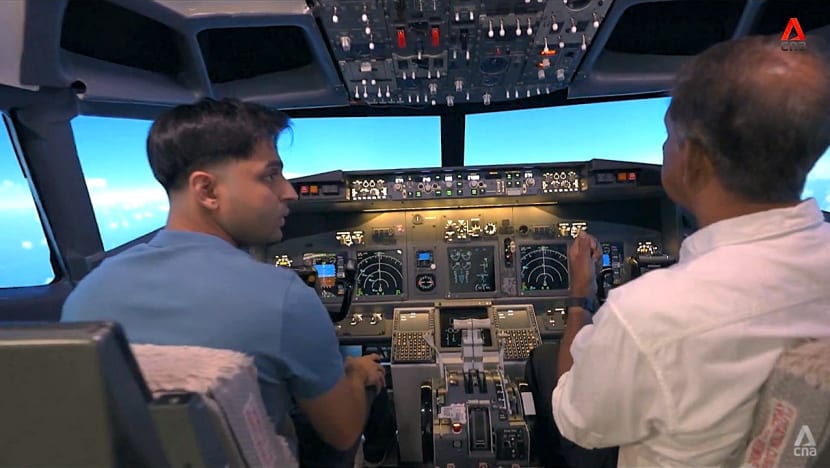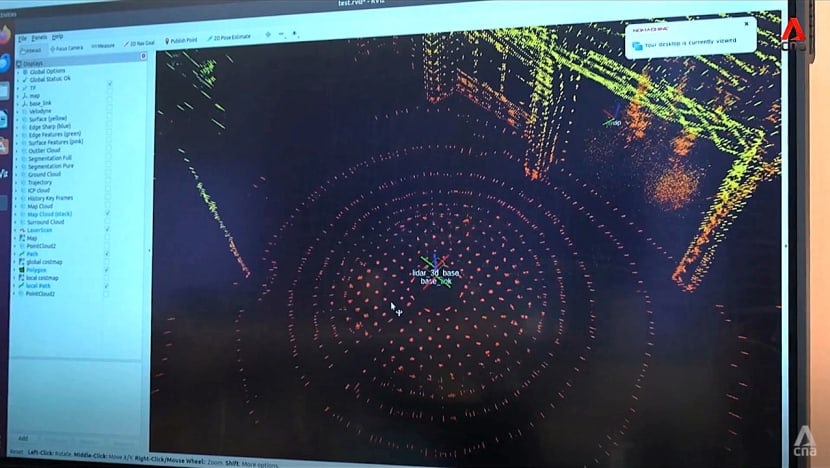Technology to mitigate dangers of air turbulence? There’s a possible solution
Following the severe turbulence that hit SQ321, the programme Talking Point finds out more about a technology commonly used in self-driving cars that could help passengers to stay safe when they fly.

Talking Point host Shrey Bhargava (left) — with retired pilot Srini R Srinivasan in a flight simulator — finds out how data on clear-air turbulence can be captured so pilots can react accordingly.

This audio is generated by an AI tool.
SINGAPORE: Clear-air turbulence — it is believed to be what hit the SQ321 flight last month and cannot be detected by radar systems.
That’s not to say nothing is able to detect it.
Research suggests that a technology commonly used in self-driving cars could mitigate the dangers of turbulence: Lidar, a 3D laser scanning technology, has been said to detect clear-air turbulence up to 20 miles (32 kilometres) ahead of an aircraft.
And avionics specialist Chang Chin Wei sees this as a possible solution going forward.
“Current weather radar systems are only capable of picking up water vapour in the clouds,” pointed out Chang, a lecturer in engineering at Nanyang Polytechnic and a former licensed aircraft engineer.
“If it’s clear-air turbulence, there’s no water vapour present. … That’s where Lidar technology comes in.”

The technology was demonstrated on the programme Talking Point, following the severe turbulence that killed one person and injured dozens of Singapore Airlines passengers.
A Lidar system on the top of a robot dog shot laser pulses and measured the time taken for each pulse to bounce off the surroundings back to the detector. The spatial information was then displayed on a screen.
In the air, a Lidar system would fire “a more focused beam” in front of the aircraft to pick up the movements of air molecules and send back the data, which would also be displayed on screen to the pilots.
The chart on the screen that Chang showed to Talking Point had many colours, which represented the distance of objects in relation to the Lidar detector. The further the object, the lighter the colour.

“Anything near the robot dog, or the detector, will be red. As it goes further, the colour changes to reflect that,” he said.
“What the pilot should be able to see (is) … air turbulence in the shape of a different colour on the screen, and then he’ll be able to know that there’s clear-air turbulence in front … and react accordingly.”
WHEN WILL IT BECOME A REALITY?
For Lidar to be deployed effectively at high altitudes, however, “you need more power” for a bigger system unit, according to Chang. “It’s very costly to have a big unit … to deploy across a fleet of aircraft in an airline.
“Air molecules, unfortunately, aren’t so predictable in this case. They have a tendency to move around,” he said. “For the Lidar detector to actually pick up … these movements of air molecules, (it must) utilise a lot of processing power.”

With a big unit, there will also be difficulty implementing the Lidar system “without adding too much weight to the aircraft when it’s flying”.
Another issue is that the higher the altitude, the shorter the detection range, he said.
In the most optimistic case, he hoped it would take three years for the technology to level up and reach “its required operating specification for it to be feasible in the air”. Or it could take “a decade or so”.
Also, regulators “generally take time” when it comes to the implementation of new technology on aircraft, he added. Airlines, meanwhile, would need both time and money to upgrade their fleet.
With new technology some years away, even as turbulence becomes more common because of climate change, what can passengers do to stay safe?
WATCH: How dangerous is aeroplane turbulence? What you should know after SQ321 (23:30)
If they happen to be stretching their legs during a long flight and unexpected turbulence hits, “experts recommend staying low and holding onto an armrest or anything nearby”, Talking Point host Shrey Bhargava learnt.
“If you happen to be in the lavatory, and the seat belt sign is switched on, hold onto the handles provided for emergencies,” he added.
There are also handles in the galley, where cabin crew prepare the meals. But passengers must be careful of the service carts, which can be dangerous during severe turbulence.
As to whether there are safer seats on the aeroplane, the ones located in the middle “may be slightly less turbulent because they’re closer to the plane’s centre of gravity”.
“But ultimately, seat selection shouldn’t have that much of an impact,” said Bhargava. “What’s more important is to always keep our seat belts fastened even when the seat belt sign is switched off.”
Watch this episode of Talking Point here. The programme airs on Channel 5 every Thursday at 9:30 p.m.




















